Rhinos are often described as living tanks, thanks to their tough, protective skin—nature’s very own armor. This rhino armor is one of the most remarkable adaptations seen in the animal kingdom. From warding off predators to withstanding harsh environmental elements, the rhino’s skin plays a crucial role in its survival.
But how exactly does this rhino skin protect the animal in the wild? Despite its seemingly impenetrable appearance, rhino skin thickness varies, serving different functions depending on the species and habitat.
Understanding this unique adaptation not only deepens our appreciation for these majestic creatures but also highlights the importance of conserving them. For wildlife enthusiasts and conservationists alike, the study of rhino skin is a gateway to ensuring the species’ protection in a world where poaching and environmental threats continue to rise.
Through this article, we’ll explore the layers of the armored rhino and discover how their tough skin acts as a vital defense mechanism in the wild.
Rhino Information Table:
| Common Name | Rhinoceros |
| Scientific Name | Rhinocerotidae (Family) |
| Family Name | Rhinocerotidae |
| Type | Mammal |
| Size | Head and Body Length: 3.0 – 4.0 meters (9.8 – 13.1 feet) |
| Tail Length | 30 – 50 cm (11.8 – 19.7 inches) |
| Weight | 800 – 3,600 kg (1,764 – 7,936 lbs) |
| Size Relative to a 6-Ft Human | 2 – 3 times larger |
| Diet | Herbivore (grasses, leaves, fruits) |
| Average Lifespan in the Wild | 35 – 50 years |
| Habitat | Savannas, grasslands, and tropical forests |
| Group Name | Crash (or Herd) |
| Found In | Africa and South Asia (depending on species) |
| Conservation Status | Varies by species (Critically Endangered to Near Threatened) |
1. The Evolution of Rhino Armor
Over millions of years, rhinos have developed their rhino armor, a thick and robust layer of skin that has played a critical role in their survival. This unique adaptation began as a response to environmental pressures, including predators, climate changes, and their often harsh, rugged habitats.
As large herbivores, rhinos needed a way to protect themselves from predators, such as big cats, and their evolution led to the formation of their iconic rhino skin—a natural shield that has withstood the test of time.
Unlike many animals whose defense mechanisms rely on speed or agility, rhinos have evolved with a slow but powerful form of protection.
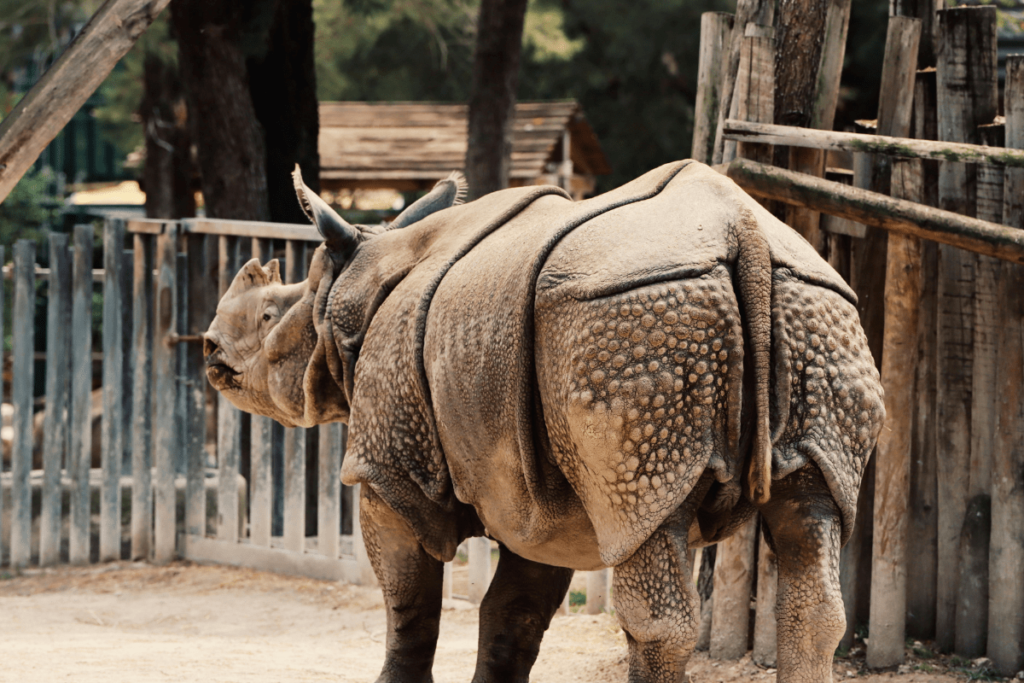
The rhino skin thickness, which can range from 1.5 to 5 centimeters, provides a formidable barrier against bites, scratches, and other forms of physical damage. This evolutionary advantage allowed rhinos to thrive in diverse environments, from the grasslands of Africa to the forests of Asia.
When compared to other animals with tough exteriors, the armored rhino stands out. For instance, while alligators and crocodiles have evolved bony plates beneath their skin called osteoderms, rhinos rely more on the sheer thickness and flexibility of their skin to absorb impacts.
Similarly, armadillos and pangolins have hard scales, but these animals are smaller and use their armor primarily for defense by curling up into a ball. In contrast, the rhino’s armor enables them to confidently roam their habitats, knowing their skin provides a shield that few predators can penetrate.
This evolutionary journey is a testament to nature’s ability to craft specialized survival tools, and the rhino’s skin remains one of the most awe-inspiring examples of natural defense in the animal kingdom.
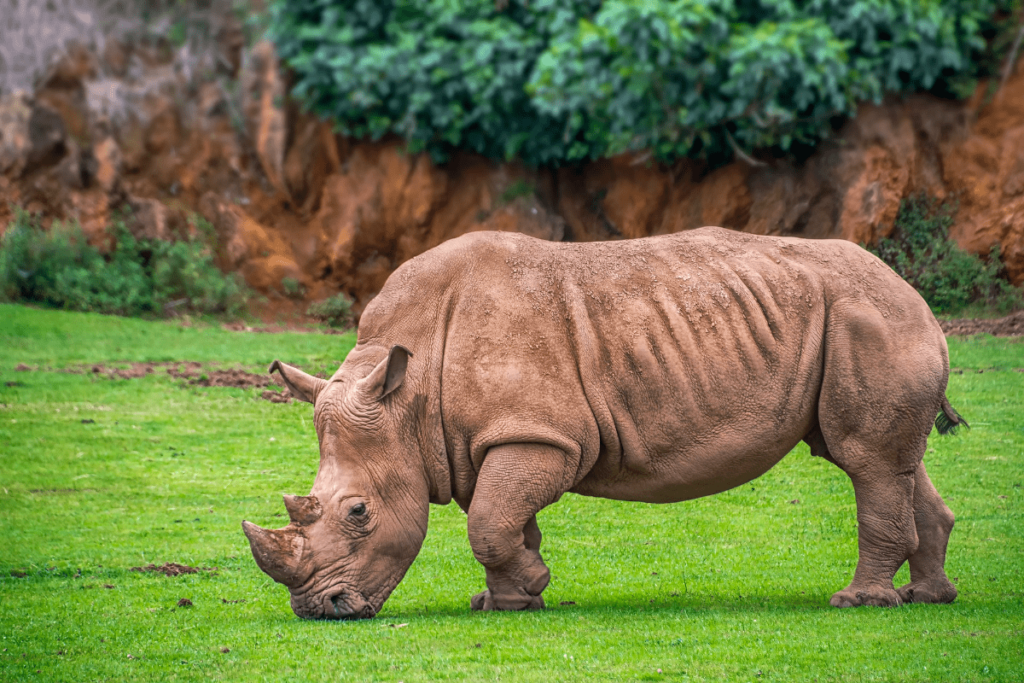
How the Rhino Got Its Skin
Rhino skin didn’t just develop overnight; it evolved over millions of years to become the remarkable armor we see today. Originally, ancestors of the modern rhino likely had thinner skin, but as environmental pressures increased and predators became more threatening, their skin adapted to provide better protection.
Through natural selection, rhino skin became thicker, more durable, and resilient, allowing them to survive in tough conditions. This evolutionary process gave rise to the armored rhino we know today, whose skin serves as both protection and adaptation to its environment.
2. The Structure of Rhino Skin
The rhino’s skin is not just thick—it is a marvel of natural engineering designed to offer both protection and flexibility. Composed of multiple layers, this rhino armor is tough enough to ward off attacks from predators and thick enough to withstand the elements. The skin is usually gray or brownish in color and is often rough, with deep folds that further enhance its protective capabilities.
Physical Characteristics:
Rhino skin is composed of several layers of epidermis and dermis, with the outermost layer being particularly thick and durable. Beneath the surface, the skin contains a dense network of collagen fibers that provide both strength and flexibility. These fibers give the skin a leathery texture, allowing rhinos to move freely despite their heavy armor.
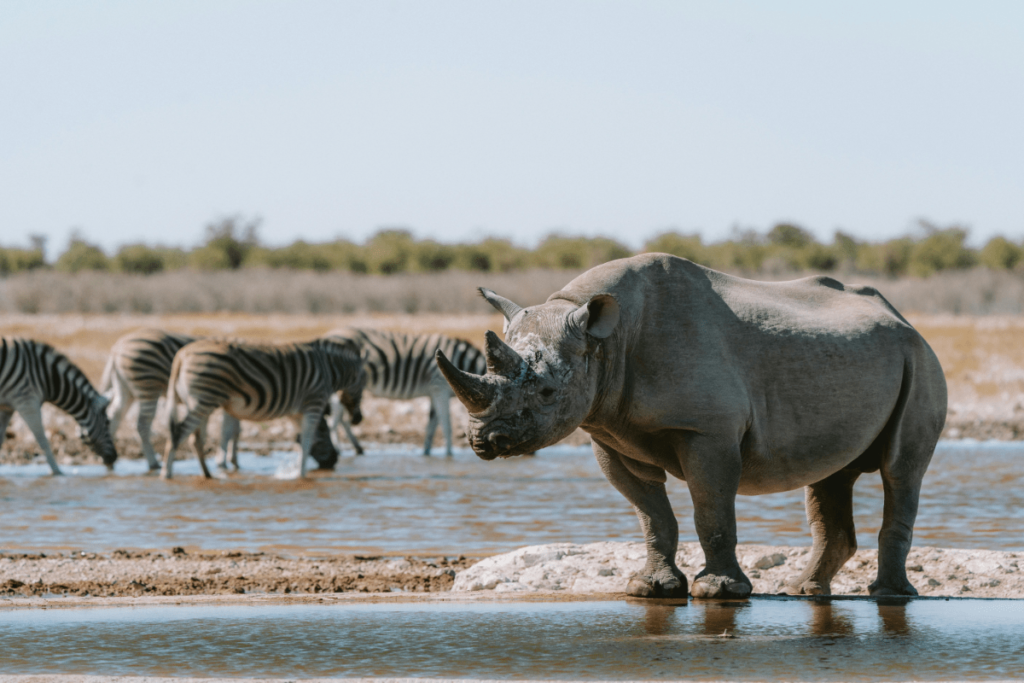
How Thick is Rhino Skin?
One of the most incredible aspects of rhino skin is its thickness. On average, rhino skin is about 1.5 to 5 centimeters (0.6 to 2 inches) thick, depending on the species and specific body areas, with the thickest parts typically located around the neck, shoulders, and back. This thick, layered skin provides extraordinary protection from predators and environmental hazards like sharp thorns, insects, and even harsh sunlight. However, despite this thickness, rhino skin is not impervious to damage, which is why they can often be seen taking mud baths to soothe their skin and ward off insects.
Is the Skin of a Rhino Hard?
Yes, but it’s not hard in the way that a rock or shell would be. While rhino skin is incredibly tough and durable, it remains flexible enough to allow the rhino to move freely. The skin has a tough outer layer, almost like a protective hide, but underneath it is softer, helping the rhino stay protected while still being able to move and interact with its surroundings. Additionally, the natural creases in the skin act as additional layers of defense, offering flexibility while preventing injury.
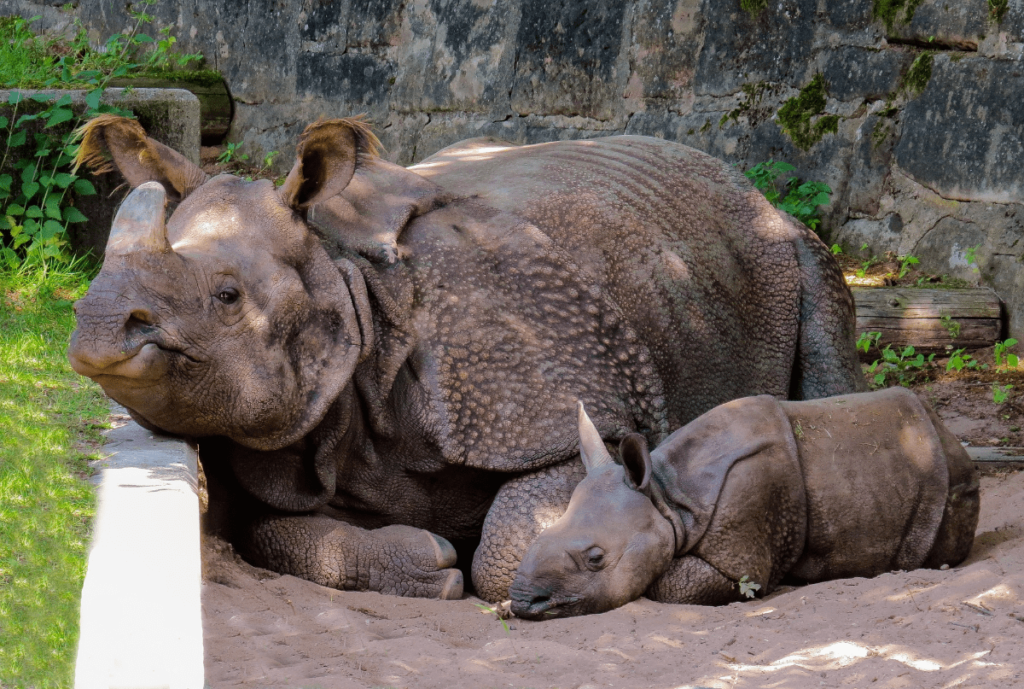
Unique Features:
The unique structure of rhino skin goes beyond its thickness. The outermost layer is covered in keratin, the same material found in human fingernails and animal horns.
This keratinized surface acts as a barrier to protect against cuts, scratches, and insect bites. The folds in the skin, especially in species like the Indian rhinoceros, form plates that help absorb impact and prevent deeper injury from predators or environmental hazards like sharp rocks or thorns.
Another important feature is the skin’s ability to regulate moisture. Though thick, rhino skin has a system of glands that secrete oils to keep the surface hydrated and prevent cracking, which is critical in hot, dry climates. Rhinos also wallow in mud to add an extra layer of protection, as the mud dries and forms a natural sunscreen and shield against parasites.
This complex structure of rhino armor not only provides physical protection but also plays a crucial role in temperature regulation and parasite control, making it one of nature’s most efficient survival mechanisms.
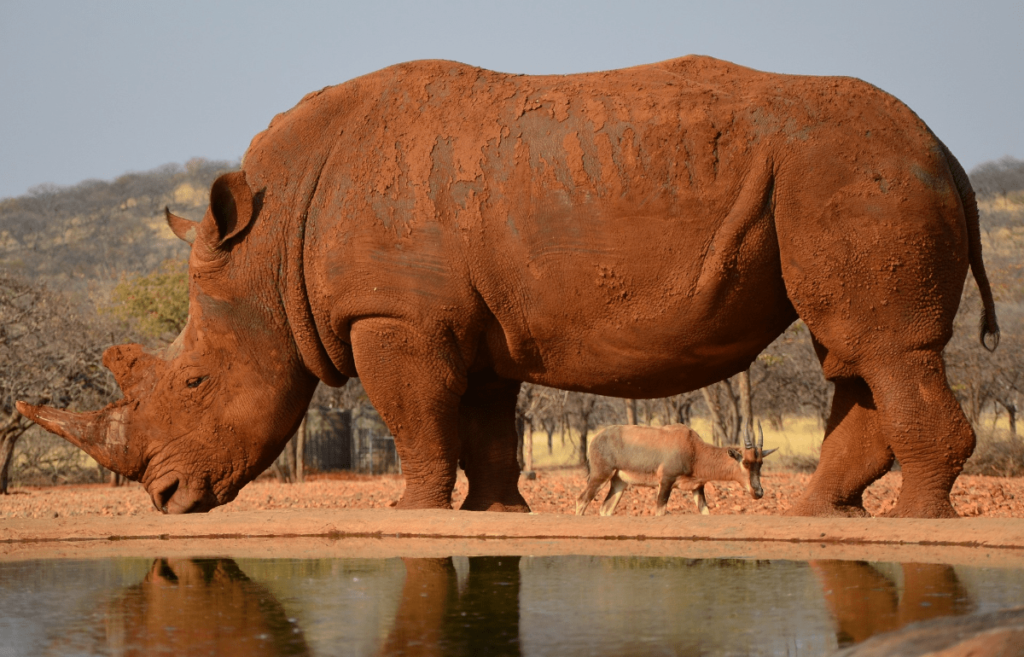
3. How Rhino Skin Protects Them
Rhinos’ rhino skin acts as a powerful line of defense, providing them with remarkable protection in the wild. Whether facing threats from predators or dealing with harsh environmental elements, the structure and characteristics of this rhino armor play a crucial role in the animal’s survival.
Defense Against Predators:
Though adult rhinos have few natural predators due to their size, young rhinos and weaker individuals can occasionally fall prey to large carnivores like lions, hyenas, and crocodiles. The rhino’s skin thickness, which can reach up to 5 centimeters in some areas, provides a natural shield against bites and scratches. This dense, fibrous structure absorbs the impact of an attack, preventing predators from penetrating deeper tissues.
The armored rhino is also equipped with folds in its skin, particularly in species like the Indian rhino. These folds act like natural body armor, making it difficult for predators to grab hold of or tear through. Even if a predator does manage to bite, the toughness and flexibility of the skin reduce the damage, allowing the rhino to fight back or flee with minimal injury.

Environmental Protection:
Beyond defense against predators, rhino skin also offers excellent protection from the harsh environments in which these animals live. Many species of rhino roam in hot, sun-drenched landscapes where the sun’s rays can be punishing. The thick, keratinized outer layer of rhino skin acts as a barrier against harmful ultraviolet rays, preventing sunburn.
Additionally, rhinos are known to roll in mud, creating a natural protective layer over their skin. Once dried, the mud serves as a form of sunscreen and protects against insects and parasites.
In regions with thorny vegetation, like African savannas or dense jungles, rhino skin serves as a safeguard against sharp branches and thorns that could easily injure other animals. The thickness of their skin allows them to push through bushes and trees without sustaining significant damage.
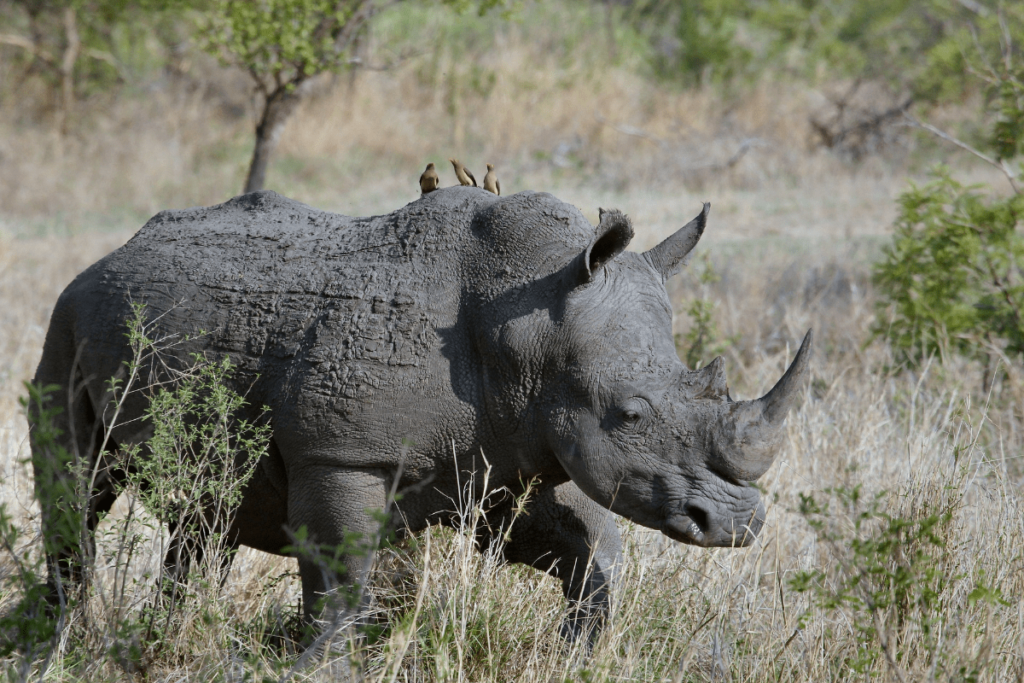
Furthermore, this rhino armor helps regulate body temperature. In hot climates, their skin’s ability to secrete oil and moisture keeps it hydrated, preventing cracking or overheating. In cooler environments, the skin acts as an insulator, maintaining the rhino’s body heat.
In essence, rhino skin is a multifunctional defense mechanism, offering protection against both biological and environmental threats, making it one of the most important factors in the survival of these incredible animals.
4. The Role of Skin in Rhinos’ Social Behavior
Rhinos’ skin plays a surprising yet essential role in their social behavior and interactions within their species. Beyond providing protection, their rhino armor is integral to how they communicate and maintain social bonds, especially in mating and other group dynamics.
Skin and Social Interactions:
Rhinos often engage in physical interactions with other rhinos, whether it’s during a territorial dispute or a more peaceful social encounter. The thick rhino skin acts as a buffer, allowing them to engage in these encounters without suffering severe injuries.
During dominance displays or battles over territory, male rhinos will often use their horns and bodies to push, shove, or ram each other. The robust nature of their skin enables these interactions, absorbing impacts that could otherwise cause significant damage. These rituals often decide the pecking order within a group without leading to fatal consequences.
Additionally, rhinos use their skin for scent marking. Rhinos have special glands in their skin that produce strong scents used to mark territory or signal reproductive status.
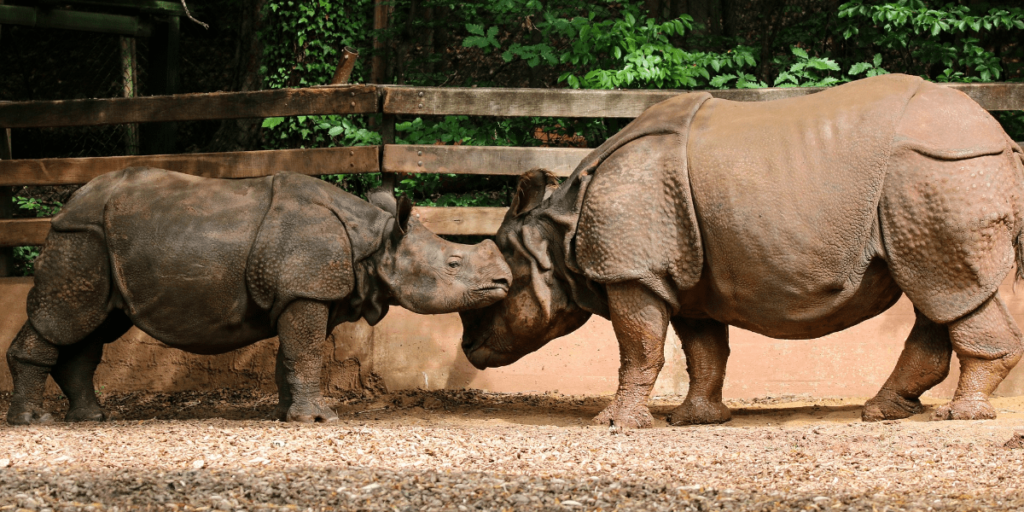
By rubbing their bodies against trees, rocks, or even other rhinos, they leave behind scent markers that help communicate their presence or intentions to other members of their species. In this way, rhino skin becomes a medium of communication, playing a vital role in their social structure.
Skin Health and Mating:
The health of a rhino’s skin is a reflection of its overall condition, which can directly influence mating success. A rhino with unhealthy or scarred skin may be less appealing to potential mates.
During mating season, males and females will assess each other’s fitness, and the condition of the rhino armor serves as a visual indicator of strength and vitality. A rhino with clear, well-maintained skin signals that it is free from disease or parasites, making it a more desirable mate.
Moreover, rhinos engage in mutual grooming, which is essential for social bonding. By rubbing against each other or engaging in wallowing behaviors, they help clean each other’s skin, removing dirt, insects, and other irritants. This shared behavior strengthens bonds, especially between mothers and calves or mating pairs, making skin care a key element in their social lives.

In conclusion, while rhino skin is primarily known for its protective qualities, it also plays a significant role in social dynamics. Whether through physical interactions, scent marking, or influencing mating choices, the condition and use of their skin are integral to rhinos’ social structure and survival.
5. Threats to Rhino Skin
Rhino skin, often referred to as rhino armor, is one of nature’s most remarkable defenses, but it faces significant threats due to human activities and environmental changes. These threats not only jeopardize the rhino’s overall survival but also compromise the health and function of their protective skin.
Poaching and Illegal Trade:
One of the most severe threats to rhinos is poaching, driven by the illegal trade of rhino horns. Although poachers primarily target the horn, the process often leaves the rhino skin severely damaged or mutilated. In some cases, poachers even strip the skin for black-market trade, where it is used in traditional medicine or sold as exotic leather.
The combination of severe injuries from poaching and the removal of their vital armor greatly reduces rhinos’ chances of survival in the wild.
Poaching also increases stress levels in rhinos, which can affect their skin health. Stress weakens their immune system, making them more susceptible to skin infections, parasites, and other diseases. These factors compound the dangers already posed by poaching, turning the rhino’s natural armor into a vulnerable target.

Habitat Loss and Environmental Stressors:
Beyond poaching, habitat loss due to deforestation, urbanization, and agriculture is another major threat to rhino skin. As their habitats shrink, rhinos are forced into smaller, more confined areas, increasing the likelihood of skin injuries from territorial conflicts or environmental hazards. The loss of natural mud wallows, which rhinos use to protect their skin from parasites and the sun, also contributes to deteriorating skin health.
Climate change adds additional pressure, as increased temperatures and changes in rainfall patterns affect the availability of water and mud wallows that rhinos rely on to cool and protect their skin. Prolonged exposure to the sun without proper wallowing can cause their rhino armor to crack or dry out, leaving them more vulnerable to disease and injury.
6. Conservation Efforts:
In response to these significant threats, global efforts are underway to protect rhinos and preserve their incredible armor. Conservation programs aim to safeguard rhinos from poaching and address the environmental factors impacting their skin health and overall survival.
Rhinos are on the brink of extinction. Discover the Critically Endangered Species Struggling to Survive
Protection Measures:
One of the most effective conservation strategies has been the implementation of anti-poaching patrols and stricter law enforcement. Wildlife reserves and protected areas are monitored with drones, patrols, and tracking technology to deter poaching and protect rhinos in the wild.
Translocation programs are also used to move rhinos from high-risk poaching zones to more secure environments, where they can thrive without the constant threat of human interference.

Habitat restoration efforts focus on preserving the ecosystems rhinos need for their well-being. By rehabilitating wetlands, reintroducing native vegetation, and protecting water sources, conservationists ensure that rhinos have access to the mud wallows and shade necessary for maintaining skin health.
These measures also promote healthier social interactions and reduce the risk of territorial disputes that could result in injuries.
How You Can Help:
There are several ways individuals can contribute to rhino conservation and help protect their unique rhino armor:
- Support Conservation Organizations: Donate to or volunteer with organizations focused on rhino protection, such as Save the Rhino International, WWF, or local wildlife reserves.
- Raise Awareness: Use social media platforms and other outreach methods to educate others about the importance of rhino conservation and the impact of poaching and habitat loss.
- Promote Sustainable Tourism: When visiting wildlife areas, choose eco-friendly tours that prioritize the well-being of rhinos and other animals, and avoid activities that could harm their habitats.
- Boycott Rhino Horn Products: Avoid purchasing products made from rhino horn or other animal-derived materials that contribute to illegal wildlife trade.
By taking these small steps, we can all play a role in safeguarding rhinos and ensuring that their magnificent armor continues to protect them in the wild for generations to come.
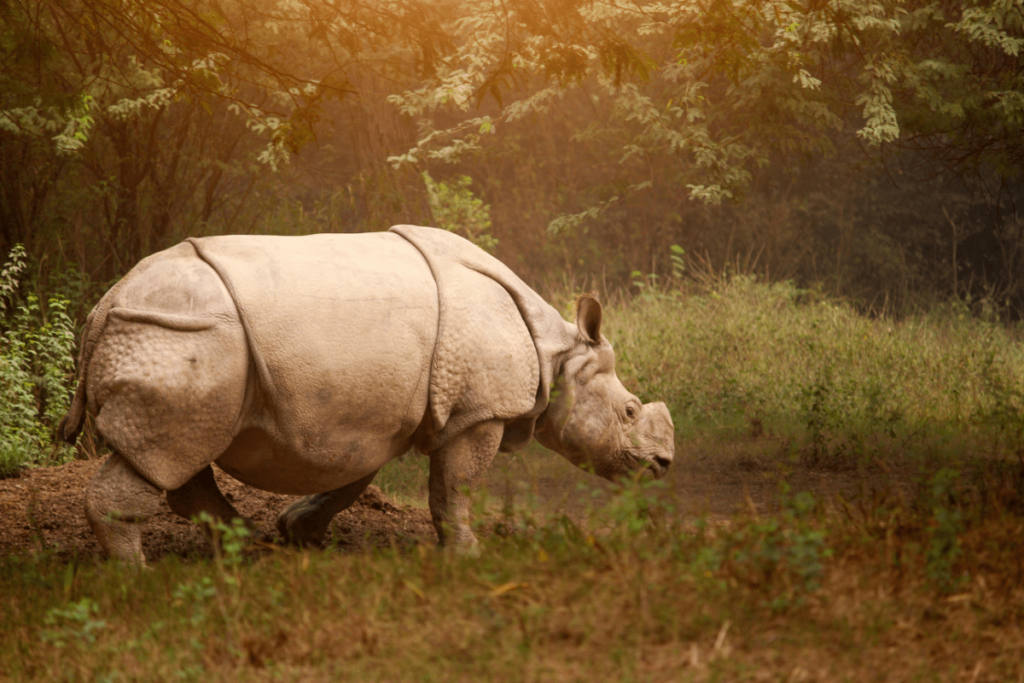
Conclusion
In conclusion, the rhino’s skin, often described as natural armor, is one of the most fascinating adaptations in the animal kingdom. Over millions of years, rhinos have evolved tough, layered skin that protects them from predators and harsh environmental conditions.
We explored how this rhino armor not only shields them in the wild but also plays a role in their social behavior. However, rhinos face significant threats today, from poaching to habitat loss, which compromise their protective armor and overall survival.
Conservation efforts, including anti-poaching patrols and habitat restoration, are crucial for ensuring that rhinos and their unique skin are preserved for future generations. By understanding the importance of rhino skin and how it supports their survival, we gain a deeper appreciation of these magnificent creatures and the urgent need for conservation.
What fascinates you most about the rhino’s impressive armor? Share your thoughts and experiences in the comments below and join the conversation. Help protect rhinos by supporting conservation initiatives, spreading awareness about the threats they face.




